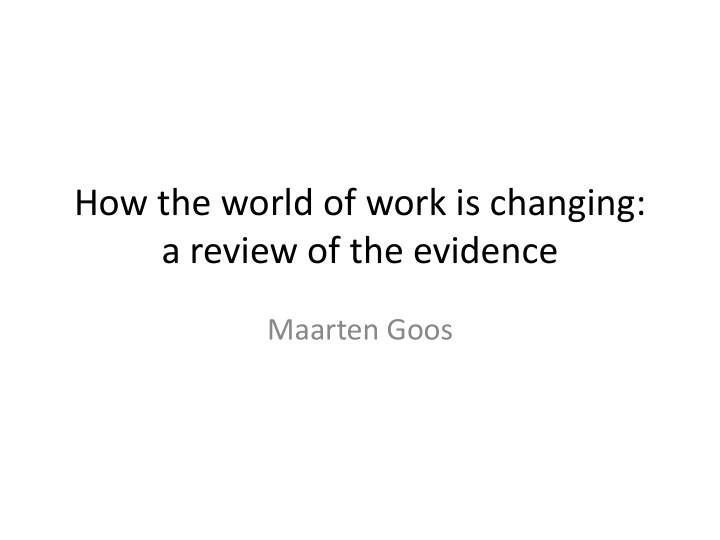



How the world of work is changing: a review of the evidence Maarten Goos
The past, present and future • The past (1820-1980): Industrial Revolution results in skill-upgrading and decreasing inequality . • The present (after 1980):Computer Revolution is leading to job polarization and increasing inequality . • But optimistic about future computerization if skills are supplied to support such changes.
The past, present and future • The past (1820-1980): Industrial Revolution results in skill-upgrading and decreasing inequality . • The present (after 1980):Computer Revolution is leading to job polarization and increasing inequality . • But optimistic about future computerization if skills are supplied to support such changes.
What explains skill-upgrading? • Introduction of purpose-built machinery (e.g. assembly line) and the rise of large factories resulted in farm laborers machine operatives. • In manufacturing, increased demand for clerks; supervisors; managerial, technical and professional occupations. • In services, increased demand for unskilled service workers (e.g. travel), medium-skilled services (e.g. sales) and skilled services (e.g. managers).
Skill-upgrading in the US occupational distribution, 1850-1880 40 35.5 33.9 35 Shift away from farm 28.8 30 Share of total employment (in %) laborers towards machine Increased demand for Increased demand for Increased demand for operatives. 25 clerks, sales; supervisors clerks, sales; supervisors clerks, sales, foremen, 21.2 (and craft), engineers and (and craft); managerial, engineers and managers 20 technical and managers 16.8 16.9 professional 15 11.8 10 7.7 5.5 3.9 5 1.5 0 1850 1860 1870 1880 Unskilled farm laborers Unskilled service workers Medium-skilled blue-collar (operatives, laborers in manufacturing) Medium-skilled white-collar (clerical,sales) Skilled blue-collar (supervisors (and craft)) Skilled white-collar (managerial, technical, professional) Source: Katz and Margo (2013)
Inequality decreased before 1980 W / W Industrialization shifted s u out the relative demand for (medium-) skilled workers which would B increase the skill premium. 1% But rapid expansion of the A education system shifted out the relative supply of C (medium) skills by more such that the skill premium -1.9% -0.6% decreased. E.g. Goldin and Katz (2008) decomposing % annualized change in the US skill premium, 1915-1940. N / N s u
The past: conclusions • Industrial Revolution lead to skill-upgrading in the occupational composition of the labor force and decreasing inequality due to rapid expansion of the education system. • Skill- upgrading (the “human capital century”) and decreasing inequality (the “great compression”) resulted in strong economic growth.
The past, present and future • The past (1820-1980): Industrial Revolution results in skill-upgrading and decreasing inequality . • The present (after 1980):Computer Revolution is leading to job polarization and increasing inequality . • But optimistic about future computerization if skills are supplied to support such changes.
What explains job polarization? • Introduction of robotic/computer equipment doing codifiable/routine tasks decreases relative demand for machine operatives and clerks • Increased relative demand for managerial, technical and professional occupations doing non-routine tasks (e.g. writing software). • Computers cannot do the non-routine tasks in unskilled service jobs (e.g. cleaning a room).
Job polarization in the US occupational distribution after 1980 40 39.4 35 30.4 30 27.9 Share of total employment (in %) 27.3 25 25.9 23.1 19.2 20 15.7 15 13.1 12.9 12.6 10 8.5 8.2 5 0.9 0.7 0 1920 1930 1940 1950 1960 1970 1980 1990 2000 2010 Medium-skilled white-collar (clerical,sales) Medium-skilled blue-collar (operatives, laborers in manufacturing) Unskilled farm laborers Unskilled service workers Skilled white-collar (managerial, technical, professional) Skilled blue-collar (supervisors (and craft)) Source: Katz and Margo (2013)
Job polarization in 16 European countries, 1993-2010 10 8 5.62 6 Percentage point change in employment share 3.65 4 2 0 Low-paying occupations Middling occupations High-paying occupations -2 -4 -6 -8 -9.27 -10 Source: Goos, Manning and Salomons (2013)
UK Sweden Spain Portugal Norway Neth. Lux. Italy Ireland Greece Germany France Finland Denmark Belgium Austria -20 -15 -10 -5 0 5 10 15 20 Percentage point changes in employment shares, 1993-2010 Middling occupations Low-paying occupations High-paying occupations Source: Goos, Manning and Salomons (2013)
Evidence on computerization Computerization increases W / W s u the relative demand for non-routine and, on net, B skilled labor. E.g. Autor, Levy and Murnane (2003) find an A annualized % increase in relative demand for skilled workers of 3.81% between 1980 and 1998 in the US of which 1.39 ppt is explained by the shift away 3.81% from routine towards non- routine tasks due to 1.39% computerization alone. N / N s u
Inequality increased after 1980 W / W Computerization (among s u other drivers) shifts out the relative demand for skills B 1.8% which increases the skill premium. C 0.5% Expansion of the education A -1% system shifts out the relative supply of skills which would decrease the skill premium but this shift out has been smaller. E.g. Goldin and Katz (2008) decompose % annualized change in the US skill premium, 1990-2005. N / N s u
The present: conclusions • Computer Revolution leads to skill-upgrading on net but also to job polarization and increasing inequality due to slowdown in educational expansion. • This is very different from the past and, so far, economic growth has been less strong (“We see computers everywhere except in the productivity statistics”).
The past, present and future • The past (1820-1980): Industrial Revolution results in skill-upgrading and decreasing inequality . • The present (after 1980):Computer Revolution is leading to job polarization and increasing inequality . • But optimistic about future computerization if skills are supplied to support such changes.
What the future should look like in a supply-demand framework W / W s u B It is most likely that the relative demand for skilled workers will continue to C increase. A D To benefit from this, continued/more rapid investment in education and on-the-job training is needed to provide the necessary skills to support such changes. N / N s u
How the world of work is changing: a review of the evidence Maarten Goos
Recommend
More recommend